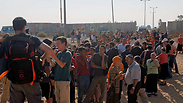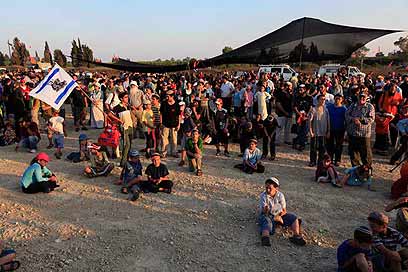
Anti-disengagement protest
צילום: אמיר כהן
Gush Katif evacuees still struggle to create new home
Almost nine years after Ariel Sharon led Israel's 'disengagement' from the Gaza Strip, the former settlers are still working to find their sense of home and overcome red tape.
When Rachel Saperstein and her husband moved to Gush Katif, the bloc of 21 Jewish settlements in the Gaza Strip, about 20 years ago, she thought they would stay there forever.
“Gush Katif was right off the Mediterranean coast and it was beautiful,” she told The Media Line wistfully, sitting in her mobile home in this town in southern Israel. “We built a beautiful house there and we thought we’d be there until our old age.”
But almost nine years ago, then prime minister Ariel Sharon decided on “disengagement” from Gaza, a policy that Saperstein calls “expulsion.”
“There is nothing worse for a human being than to watch the Israeli army – the army we love - come in and take us out of our home,” Saperstein, 73, says angrily.
“These three little girl soldiers came in and said, “Mr. and Mrs. Saperstein, we are here by the edict of the Israeli government to tell you that you have to leave your home.” I looked at the three little girls and said, “You must remember that today is the day you threw out Jewish grandparents from their home in Israel.”
Saperstein had to be forcibly carried out of her home by the soldiers. For a year, she and her husband lived in a small Jerusalem hotel room. Then they came here to this town in southern Israel, where they were given a “caravilla” a large mobile home to live in while they built their permanent home.
They were supposed to be in Nitzan for three years. It is now almost eight years, and there is no sign that she will be moving out soon.
“They gave us an amount of money and said, 'That’s it. Go build your house,'” she said. “Well, prices have gone up significantly since then. We’re stuck with a house that’s half -built. We have flooring in but we can’t afford to finish it.”
She says hundreds of families are in a similar situation, and can’t afford to finish building their new homes. Some 1800 families were evacuated from Gaza in 2005. So far, only about half have moved into their permanent homes, and the other half are either renting apartments or live here in Nitzan.
The Israeli government says it has done everything possible to help the evacuees from Gush Katif succeed in their new lives. Most families received between $450,000 and $750,000 depending on how long they lived in Gush Katif and how big their homes were there. Some farmers received even larger amounts of money.
At the same time, unemployment is high among the evacuees from Gush Katif. While the overall unemployment rate in Israel is just six percent, among those evacuees from Gush Katif, it is close to 25 percent. Many of those not working are using the government payouts to live on, rather than to build new homes.
“I was a farmer in Gush Katif and I thought about opening a new farm near hear,” Yehiam Sharabi, 66, told The Media Line. “But my sons thought they didn’t want to farm and I thought it would take too long to get it started. It takes years, maybe even a generation, to get to know the soil. Many of those who did start farms didn’t succeed.”
Sharabi’s wife found a job in early childhood education, and he has worked off and on since then. Only now is he finalizing the building plans for his new house nearby.
“I just wasn’t ready to do it until now,” he says. “I needed to do it at my own pace and in my own time. Now I’m dealing with the bureaucracy and hope to start building soon.”
He says that financially he’ll manage because he was careful about hoarding his money from the government. He also received a larger settlement, because of the land of his farm.
“A lot of people were tempted by bad investments and get-rich-quick schemes,” he said. “Now those people have no money left.”
In 2010, a government investigative committee chaired by retired judge Eliahu Matza found both the evacuees and the government responsible for the difficult situation many are still facing. The evacuees faced a clumsy bureaucracy and “state insensitivity.” The evacuees “made exaggerated demands.”
Some of the evacuees, like Miriam Bublil, have successfully built homes and moved on. She runs the community center in Nitzan, as she did in Gush Katif.
“This is a place to forget all of the tensions and just have fun,” she says of the community center. “It was very important to the children that I was with them in Gush Katif, and then was with them here.”
Article written by Linda Gradstein
Reprinted with permission from The Media Line











